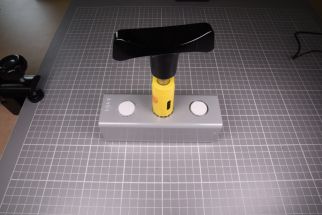Adhesive bonding has attracted more and more attention in recent years and its share across industry (automotive, construction, etc.) is increasing. This is mainly due to the good mechanical properties and low technological demands of bonding compared to conventional methods such as welding.
Adhesive bonding is a method of material bonding using adhesive, where a permanent, non-detachable joint is formed.
An adhesive is a substance that has the ability to bond two surfaces based on adhesion and its own cohesion. Adhesion and cohesion are thus essential properties defining the substance as an adhesive.
Adhesion of the adhesive to the surface is based on the molecular structure of the adhesive and results from the action of physical, chemical and intermolecular bonding forces. Several models have been developed for the description of adhesion:
- Mechanical theory. Adhesion is caused by solidification of an adhesive in cracks, cavities and pores of bonded material.
- Electrostatic theory. Adhesion is based on electrostatic forces and the adhesive/material interface can be described as a capacitor.
- Diffusion theory assumes mutual diffusion of macromolecules of an adhesive and polymer material intended for bonding.
- Chemical bonding assumes formation of chemical bonds at the adhesive/material interface
- Adsorption (thermodynamic) theory. Unlike the theory of chemical bonding, adsorption theory assumes formation of a joint through intermolecular interactions of van der Waals forces.
Cohesion of the adhesive is related to the intermolecular and valence forces in the adhesive structure. The amount of energy required to pull the adhesive particle out of the structure is characterized by decohesive energy.
Adhesive bonding is at present a fully-fledged alternative to other materials bonding techniques. The main advantages are:
- variability of materials that can be combined,
- variability of desired properties of the final joint,
- minimizing the risk of corrosion damage due to galvanic corrosion when different metals are connected,
- absorption of vibration and high fatigue resistance.
Disadvantages of adhesive joints are above all in the necessity of a proper surface preparation and precise compliance to the recommended procedure, including the need to fix the bonded materials until the adhesive cures in the joint. Service life of the joint also depends heavily on the environment and temperature. Factors affecting the quality and functionality of the adhesive joint can be divided into three categories:
|
Material |
Adhesive |
Conditions |
|
• surface geometry • wettability • surface cleanliness • solubility • swelling • thermal expansion |
• degree of polymerization • viscosity • homogeneity • pH • volume stability • structure and composition of the filler |
• construction of the joint • surface treatment • application of the adhesive • pressure and fixation • cure conditions |
Notes to selected factors:
- Surface of the material needs to be sufficiently wettable for quality joint.
- Solubility and swelling represent in most cases undesirable interactions between adhesive and the material.
- Thermal expansion. Different thermal expansion of the bonded material and adhesive or two dissimilar bonded materialsleads to increased mechanical stress and shorten the service life of the joint.
- Volume stability. Volume contractions caused by the solidification of the adhesive can introduceadditional mechanical stress to the joint.
- Construction of the joint. Choice of suitable layout and joint geometry based on expected load.
A wide range of adhesives and adhesive systems currently available can be sorted by a variety of aspects and properties:
- By origin:
- Natural or synthetic.
- Inorganic and organic.
- By curing mechanism:
- Reactive
- cured by hardener (multi-component adhesives),
- cured by presence of relative humidity,
- cured by temperature,
- cured by radiation (UV),
- cured in anaerobic conditions (when in contact with metal).
- Non-reactive
- hot-melt adhesives,
- solvent based adhesives,
- dispersion adhesives,
- contact adhesives.
- Reactive
- By chemical composition:
- Epoxy, acrylate, rubber, cellulose derivate adhesives, polyurethane etc.
- By thermal properties:
- Thermosetting.
- Thermoplastic.
- Rubber.
- By viscosity, by water resistance etc.
Evaluation of bonded joints properties
Properties of bonded joints are determined by a range of procedures and tests:
- Evaluation of tensile, shear, peeling, static and impact strength of bonded joints by standardized tests. Sample geometry and type of stress vary based on the test. After the test, adhesive and cohesive failures of tested bond are evaluated.
- Evaluation of aging, e. effect of temperature, humidity, UV radiation and environment on long-term durability and properties, for example in cyclic tests.
- Non-destructive methods such as defectoscopy (acoustic, ultrasonic) to detect hidden joint defects. These procedures cannot determine the strength.
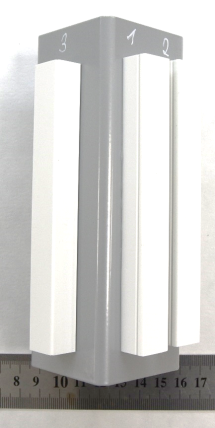 |
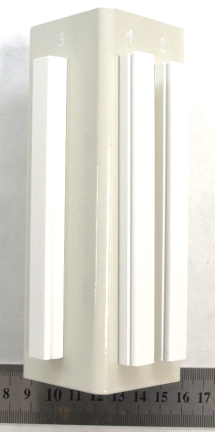 |
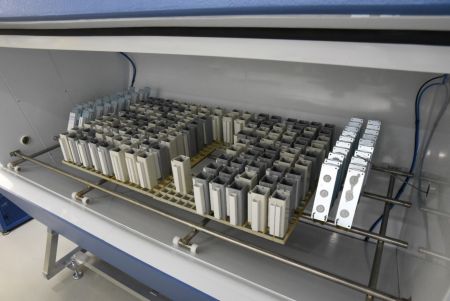
Exposure of samples with bonded joints in corrosion chamber
Technopark Kralupy currently offers testing according to the following standards:
ISO 4624 Paints and varnishes – Pull-off test for adhesion. It is a quantitative evaluation of the coating adhesion to a metallic substrate. The coating can be tested in cured form or after exposure test, e.g. accelerated corrosion test VW P1210 or after degradation of the organic coating by ultraviolet or broad-spectrum light.
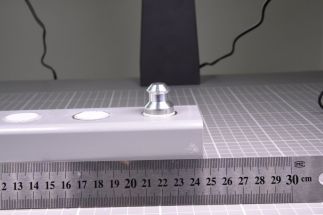 |
|
Sample preparation for pull-off test according to ISO 4624
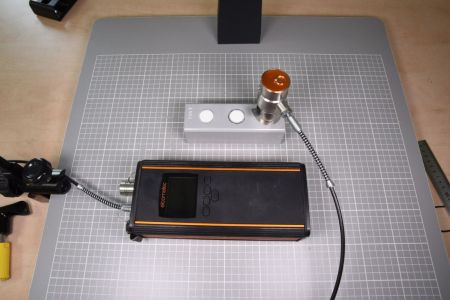
Device for pull-off test according to ISO 4624
ISO 9142 Adhesives – Guide to the selection of standard laboratory ageing conditions for testing bonded joints. Test for degradation of bonded joints in various configurations:
- Conditions simulating atmospheric exposure (23 ± 2 °C, 50 ± 5 % relative humidity, RH).
- Increased temperature (20-200 ° C).
- Reduced temperature (-20 and -40 ° C).
- Constant elevated or reduced humidity (25-100 % RH).
- Increased atmospheric pressure.
- Cyclic variations of the conditions (combination of the above).
Tests of bonded assemblies – test of the strength of a bonded joint under mechanical load. The test can be done in several configurations:
- T-peel test (ISO 11339, ASTM D5170, ASTM F88).
- 180-degree peel test (ISO 8510-2, ASTM D1000, ASTM D3330).
- 90-degree peel test (ISO 8510-1, ISO 29862, ASTM D5109, ASTM 2861, ASTM 5375).
EN 1465 Adhesives – Determination of tensile lap-shear strength of bonded assemblies. Test to assess the mechanical strength of a bonded joint under shear mechanical loading.
ISO 4587 Adhesives – Determination of tensile lap-shear strength of rigid-to-rigid bonded assemblies.
ISO 10365 Adhesives – Designation of main failure patterns. Regulation defining the type of failure at various interfaces (adhesion), in the bonded material (decohesion), etc.
ISO 175, ISO 291, ISO 483 – Tests of chemical resistance. Mostly immersion tests to assess the resistance to chemicals in liquid form.
ISO 4892-1, ISO 4892-2, ISO 4892-3 – Radiation degradation tests. Tests of degradation of plastics in broad-spectrum radiation, which corresponds to the spectrum of solar radiation or in the narrow spectrum of UV (UV-A, UV-B) radiation. Critical test to assess the resistance of adhesives, especially in exteriors. For more information, see the climatic tests.
Literature:
Petrie, E. M. Handbook of Adhesives and Sealants, 1st ed.; McGraw Hill Professional, 1999.
Pizzi, A., Mittal, K. L., Eds. Handbook of Adhesive Technology, 2nd ed.; Marcel Dekker, Inc.: New York, 2003.
About us
Technopark Kralupy is a spin-off of The University of Chemistry and Technology Prague serving the Czech and international industry in the field of building chemistry and similar subjects since 2015.
Contact
Department of Metallic Construction Materials
Technopark Kralupy of the University of Chemistry and Technology Prague
Technopark Kralupy VŠCHT Praha
Náměstí G. Karse 7
278 01 Kralupy nad Vltavou
Czech Republic
kovy@technopark-kralupy.cz
Phone: +420 220 446 104, +420 723 242 413
© 2017–2024 Technopark Kralupy

